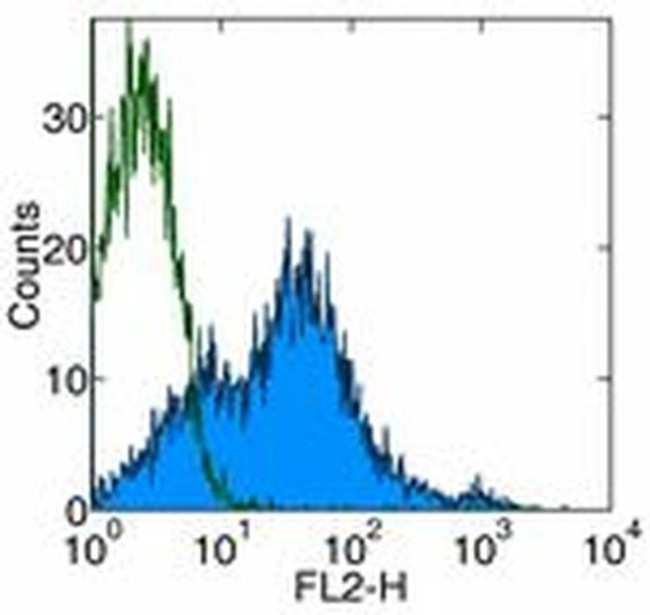Search Thermo Fisher Scientific
Invitrogen
CD81 Monoclonal Antibody (Eat-2 (EAT2)), Functional Grade, eBioscience™
Product Details
16-0811-82
Species Reactivity
Published species
Host/Isotype
Recommended Isotype Control
Class
Type
Clone
Conjugate
Form
Concentration
Purification
Storage buffer
Contains
Storage conditions
Shipping conditions
RRID
Product Specific Information
Description: The Eat-2 (EAT2) monoclonal antibody reacts with mouse CD81, a molecule also known as TAPA-1. CD81 is expressed on CD4^+CD8^+ thymocytes and broadly in the periphery with high level expressed by B cells, NK cells, macrophages and dendritic cells and lower level on resting T cells. Activation of T cells induces upregulation of CD81. CD81 is involved in homotypic adhesion of B and T cells as well as costimulation of T cells. The Eat-2 antibody is reported to cross-react with rat CD81.
Applications Reported: The Eat-2 (EAT2) antibody has been reported for use in flow cytometric analysis, immunoprecipitation, and immunoblotting (WB).
Applications Tested: The Eat-2 (EAT2) antibody has been tested by flow cytometric analysis of mouse thymocytes and splenocytes. This can be used at less than or equal to 0.5 µg per test. A test is defined as the amount (µg) of antibody that will stain a cell sample in a final volume of 100 µL. Cell number should be determined empirically but can range from 10^5 to 10^8 cells/test. It is recommended that the antibody be carefully titrated for optimal performance in the assay of interest.
Storage and handling: Use in a sterile environment.
Filtration: 0.2 µm post-manufacturing filtered.
Purity: Greater than 90%, as determined by SDS-PAGE.
Endotoxin Level: Less than 0.001 ng/µg antibody, as determined by LAL assay.
Aggregation: Less than 10%, as determined by HPLC.
Target Information
CD81 (TAPA-1, target of anti-proliferative antibody-1) is a member of the tetraspanin family, is expressed on virtually all nucleated cells, but above all on germinal center B cells. CD81 forms complexes with other tetraspanin proteins, integrins, coreceptors, MHC class I and II molecules, and influences adhesion, morphology, activation, proliferation and differentiation of B, T cells. In muscles, CD81 promotes cell fusion and myotube maintenance. CD81 has been also identified as a receptor for the hepatitis C virus. Like members of the tetraspanin family that include CD9, CD37, CD53, CD63, and CD82, CD81 is a cell-surface proteins that are characterized by the presence of four hydrophobic domains. The proteins mediate signal transduction events that play a role in the regulation of cell development, activation, growth and motility. CD81 is a cell surface glycoprotein that is known to complex with integrins. CD81 appears to promote muscle cell fusion and support myotube maintenance. CD81 associates with CD19, CD21, Leu 13, and integrins on cell membrane and acts as a receptor for the envelope protein E2 of chronic hepatitis C virus. Antibodies to CD81 have anti-proliferative effects on different lymphoid cell lines, particularly those derived from large cell lymphomas. CD81 is also localized in the tumor-suppressor gene region and is a candidate gene for malignancies.
For Research Use Only. Not for use in diagnostic procedures. Not for resale without express authorization.
Bioinformatics
Protein Aliases: 26 kDa cell surface protein TAPA-1; CD81; CD81 antigen; Target of the antiproliferative antibody 1; Tetraspanin28
Gene Aliases: Cd81; Tapa-1; Tapa1; Tspan28
UniProt ID: (Mouse) P35762
Entrez Gene ID: (Mouse) 12520

Performance Guarantee
If an Invitrogen™ antibody doesn't perform as described on our website or datasheet,we'll replace the product at no cost to you, or provide you with a credit for a future purchase.*
Learn more
We're here to help
Get expert recommendations for common problems or connect directly with an on staff expert for technical assistance related to applications, equipment and general product use.
Contact tech support

